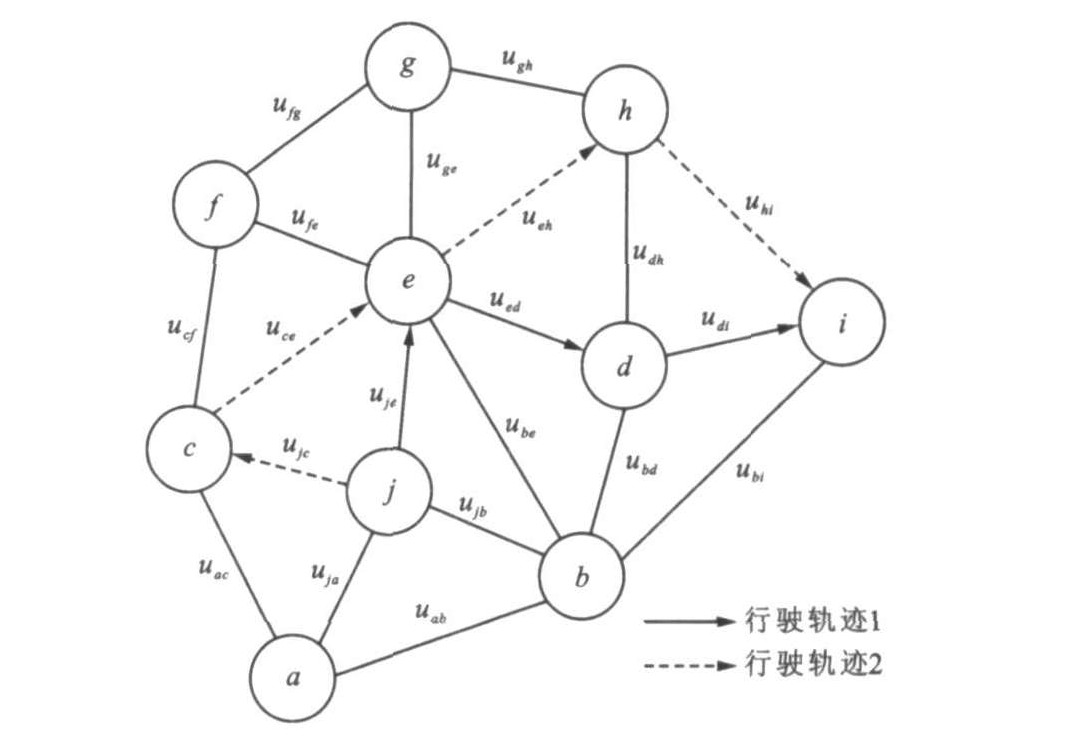-
摘要: 为确定城市出租车的合理发展规模, 研究了城市出租车网络的运营特性与载客和空载阶段的出租车路径选择行为特征, 分析了固定需求条件下出租车运营网络的供需平衡关系, 建立了城市出租车网络平衡模型, 以客观地反映驾驶员的搜客行为规律, 表征城市道路网、出租车运营规模、出租车搜索时间和乘客候车时间的相关关系, 并针对模型结构特征设计了模型求解的迭代求解算法。算例计算分析表明, 算法是收敛的, 模型是可行的, 能根据乘客等待时间确定城市出租车的合理发展规模, 有利于城市出租车网络的规划与管理。Abstract: The operation characteristics of urban taxi service network were researched in order to determine the reasonable development quantity of urban taxis. A new equilibrium model of taxi service network was developed, the route-choosing behaviours of occupied and vacant taxis and the supply-demand equilibrium relation of taxi service network in deterministic demand condition were analyzed, so that the model could describe taxi drivers' searching behaviours and the relationships among road network, taxi quantity, drivers' searching time and passengers' waiting time. A solution algorithm was designed according to the model structure. The computation result of simple numerical example shows that the algorithm is convergent, the method is feasible, the model can determine the reasonable development quantity of urban taxis according to given passengers' waiting time, which may offer some beneficial guidance and theoretic basis to the planning and management of urban taxi network.
-
表 1 OD矩阵
Table 1. OD matrix
交通区 1 2 3 4 5 6 7 Qi 1 0 40 20 20 30 20 10 140 2 30 0 10 30 20 20 20 130 3 20 20 0 30 40 30 20 160 4 30 10 10 0 20 10 20 100 5 40 10 20 30 0 20 40 160 6 10 20 10 10 30 0 30 110 7 20 30 20 20 20 30 0 140 Qj 150 130 90 140 160 130 140 940 表 2 可能搜索路径集
Table 2. Possible searching route aggregates
交通区对 可能搜索路径 区间搜索时间/min 交通区对 可能搜索路径 区间搜索时间/min 1→2 1→2 5 6→3 6→7→3 12 1→7→2 9 6→1→2→3 15 1→6→7→2 19 6→5→4→3 19 1→7→3→2 12 6→7→1→2→3 19 1→7→4→3→2 16 6→7→4→3 16 7→5 7→5 7 6→7→2→3 16 7→6→5 17 6→1→7→3 15 7→4→5 10 6→1→7→4→3 19 7→3→4→5 15 6→1→7→2→3 19 7→1→6→5 19 6→5→7→3 20 7→2→3→4→5 19 6→5→4→3 19 表 3 计算过程
Table 3. Calculating process
迭代次数 交通区 1 2 3 4 5 6 7 w Z w Z w Z w Z w Z w Z w Z w w w w w w w 0 1.16 0.16 1.34 0.34 0.92 0.08 1.93 0.93 0.85 0.15 1.58 0.58 1.27 0.27 1.00 1.00 1.00 1.00 1.00 1.00 1.00 1 1.01 0.14 1.12 0.16 1.01 0.10 1.45 0.25 1.02 0.20 1.21 0.23 1.02 0.20 1.16 1.34 0.92 1.93 0.85 1.58 1.27 2 1.09 0.08 1.29 0.15 0.94 0.07 1.61 1.11 0.91 0.11 1.31 0.08 1.15 0.13 1.01 1.12 1.01 1.45 1.02 1.21 1.02 3 1.04 0.05 1.11 0.14 0.99 0.05 1.55 0.04 0.99 0.09 1.25 0.05 1.06 0.08 1.09 1.29 0.94 1.61 0.91 1.31 1.15 4 1.07 0.03 1.17 0.05 0.95 0.04 1.60 0.04 0.94 0.05 1.30 0.03 1.11 0.05 1.04 1.11 0.99 1.55 0.99 1.25 1.06 -
[1] Douglas G W. Price regulation and opti malservice standards: the taxicab industry[J]. Journal of Transport Economics and Policy, 1972, 6(2): 116-127. [2] Beesley M E. Regulation of taxi[J]. Economic Journal, 1973, 83(1): 72-150. [3] De Vany A S. Capacity utilization under alternative regulation restraints: an analysis of taxi markets[J]. Journal of Political Economy, 1975, 83(1): 83-94. doi: 10.1086/260307 [4] Beesley M, Glaister S. Information for regulating: the case of taxis[J]. Economic Journal, 1983, 93(4): 594-615. [5] Schroeter J R. A model of taxi service under fare structure and fleet size regulation[J]. Bell Journal of Economics, 1983, 14(1): 81-96. doi: 10.2307/3003539 [6] Foerster J F, Gilbert G. Taxicab deregulation: economic consequences and regulatory choices[J]. Transportation, 1979, 8(4): 371-387. doi: 10.1007/BF00167989 [7] Hackner J, Nyberg S. Deregulating taxi services: a word of caution[J]. Journal of Transport Economics and Policy, 1995, 29(2): 195-207. [8] Arnott R. Taxi travel should be subsidized[J]. Journal of Urban Economics, 1996, 40(3): 316-333. doi: 10.1006/juec.1996.0035 [9] Cairns R D, Liston H C. Competition and regulation in the taxi industry[J]. Journal of Public Economics, 1996, 59(1): 1-15. doi: 10.1016/0047-2727(94)01495-7 [10] Yang Hai, Wong S C. A network model of urban taxi services[J]. Transportation Research: Part B, 1998, 32(4): 235-246. doi: 10.1016/S0191-2615(97)00042-8 [11] Wong KI, Wong S C, Yang Hai. Modeling urban taxi services in congested road network with elastic demand[J]. Transportation Research: Part B, 2001, 35(9): 819-842. doi: 10.1016/S0191-2615(00)00021-7 [12] Yang Hai, Wong S C, Wong KI. Demand-supply equilibrium of taxi services in a network under competition and regulation[J]. Transportation Research: Part B, 2002, 36(9): 799-819. doi: 10.1016/S0191-2615(01)00031-5 [13] Yang Hai, Ye Min, Wilson HT, et al. Regulatingtaxi services in the presence of congestion externality[J]. Transportation Research: Part A, 2005, 39(1): 17-40. [14] 周晶, 何建敏, 盛邵瀚. 城市出租车运营系统的随机分析[J]. 管理工程学报, 2000, 14(1): 63-66. https://www.cnki.com.cn/Article/CJFDTOTAL-GLGU200001019.htmZhou Jing, He Jian-min, Sheng Shao-han. Random analysis of urban taxi service system[J]. Journal of Industrial Engineering and Engineering Management, 2000, 14(1): 63-66. (in Chinese) https://www.cnki.com.cn/Article/CJFDTOTAL-GLGU200001019.htm [15] 陆建, 王炜. 城市出租车拥有量确定方法[J]. 交通运输工程学报, 2004, 4(1): 92-95. http://transport.chd.edu.cn/article/id/200401023Lu Jian, Wang Wei. Confirming method of urban taxi quantity[J]. Journal of Traffic and Transportation Engineering, 2004, 4(1): 92-95. (in Chinese) http://transport.chd.edu.cn/article/id/200401023 [16] 四兵锋, 孙壮志, 赵小梅. 基于随机用户平衡的混合交通网络流量分离模型[J]. 中国公路学报, 2006, 19(1): 93-98. https://www.cnki.com.cn/Article/CJFDTOTAL-ZGGL200601019.htmSi Bing-feng, Sun Zhuang-zhi, Zhao Xiao-mei. Mixed traffic network flow-split model based on stochastic user equilibrium[J]. China Journal of Highway and Transport, 2006, 19(1): 93-98. (in Chinese) https://www.cnki.com.cn/Article/CJFDTOTAL-ZGGL200601019.htm [17] 张生瑞, 周伟, 姜彩良, 等. 城市客运结构评价体系及评价方法[J]. 长安大学学报: 自然科学版, 2004, 24(4): 59-62. https://www.cnki.com.cn/Article/CJFDTOTAL-XAGL200404014.htmZhang Sheng-rui, Zhou Wei, Jiang Cai-liang, et al. Evaluationindices and model of urban passenger transport system[J]. Journal of Chang an University: Natural Science Edition, 2004, 24(4): 59-62. (in Chinese) https://www.cnki.com.cn/Article/CJFDTOTAL-XAGL200404014.htm [18] 边扬, 王炜, 陆建, 等. 城市出租车出行方式分担率预测方法研究[J]. 交通运输系统工程与信息, 2006, 6(2): 95-100. https://www.cnki.com.cn/Article/CJFDTOTAL-YSXT200602018.htmBian Yang, Wang Wei, Lu Jian, et al. Aforecasting method for urbantaxi traffic mode split rate[J]. Journal of Transportation Systems Engineering and Information Technology, 2006, 6(2): 95-100. (in Chinese) https://www.cnki.com.cn/Article/CJFDTOTAL-YSXT200602018.htm -





 下载:
下载:




